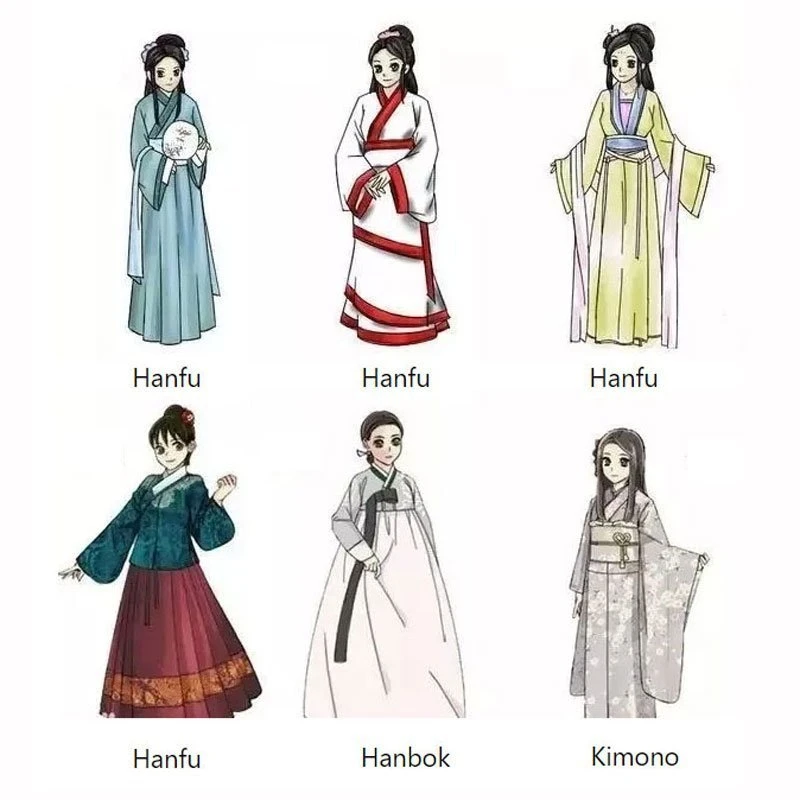A Comparative Journey through Chinese Hanfu vs Japanese Kimono Styles
Embarking on a journey to explore the rich tapestry of traditional Asian attire, we delve into the intricacies of two iconic garments: the Chinese Hanfu and the Japanese Kimono. These traditional garments are not merely Clothing; they are a reflection of the cultural heritage and historical evolution of their respective societies. As we traverse this comparative path, we uncover the unique characteristics and shared elements that define these two emblematic styles.
Hanfu, a term derived from the Han Chinese ethnic group, dates back to the Yellow Emperor and has evolved through various dynasties. It is characterized by its flowing silhouette and intricate patterns, often symbolizing the wearer’s social status and wealth. The Japanese Kimono, on the other hand, has its roots in the Heian period, showcasing a refined elegance with its structured fit and a wide array of motifs that depict the changing seasons and cultural aesthetics.

The Historical Context of Chinese Hanfu vs Japanese Kimono
The historical context of these garments is paramount to understanding their significance. The Hanfu, with its origins in ancient China, has seen numerous transformations, from the Zhou Dynasty’s simple yet profound designs to the Ming Dynasty’s elaborate and luxurious embroidery. Each dynasty left its imprint, creating a rich narrative of Chinese history and philosophy woven into the fabric of the Hanfu.
Similarly, the Kimono has undergone its own metamorphosis, from the T-shaped Hitoe to the modern Furisode, reflecting the shifting cultural and social dynamics of Japan. The Kimono‘s evolution is a testament to the Japanese spirit of innovation and reverence for tradition.
Cultural Significance and Symbolism
The cultural significance of the Hanfu and Kimono extends beyond their aesthetic appeal. The Hanfu‘s deep cultural roots are evident in its symbolism, where colors, patterns, and even the way it is worn can convey a sense of respect and harmony with nature. The Kimono, too, is steeped in symbolism, with each pattern and color holding a specific meaning, often related to the seasons, social status, or personal attributes.
“The Kimono is more than an attire; it is a canvas of Japanese art and philosophy,” noted a renowned kimono designer on their official Twitter account. This perspective encapsulates the essence of the Kimono as not just a garment but a medium of artistic expression and cultural storytelling.
Modern Interpretations and Global Influence
In the contemporary era, both the Hanfu and Kimono have transcended their traditional roles and have become symbols of cultural pride and identity. The resurgence of the Hanfu movement in China and the global popularity of the Kimono in fashion and pop culture demonstrate the timeless allure and adaptability of these garments.
The Hanfu‘s influence can be seen in various international fashion weeks, where designers incorporate its elements into modern collections, blending tradition with innovation. Similarly, the Kimono has inspired designers worldwide, who reinterpret its classic elegance for a global audience.

Conclusion of the Journey
As our comparative journey through the Chinese Hanfu vs Japanese Kimono styles comes to an end, we are left with a profound appreciation for the depth and diversity of traditional Asian fashion. These garments are more than mere clothing; they are a living embodiment of the cultural, historical, and artistic legacy of China and Japan. As we reflect on the intricate craftsmanship, rich symbolism, and enduring influence of the Hanfu and Kimono, we recognize their significance as treasured artifacts of human creativity and cultural expression.
In the words of a prominent fashion historian, “The Hanfu and Kimono are not just garments; they are the soul of their people, a reflection of their spirit and a testament to their enduring legacy.” As we continue to celebrate and preserve these cultural treasures, we ensure that their stories are passed on to future generations, inspiring a deeper understanding and appreciation of the rich tapestry of human culture.








The article’s comparison of Hanfu and Kimono from a modern perspective was insightful. It’s inspiring to see how these traditional garments have influenced contemporary fashion globally.
I’m a textile designer, and the craftsmanship behind both Hanfu and Kimono is awe-inspiring. The article does a great job of highlighting their artistic value, but I wish it had included more details about the fabrics and techniques used.
The article claims that Hanfu symbolizes wealth and status, but I think it oversimplifies its cultural meaning. Hanfu is also about harmony with nature and Confucian values, which the article could have explored further.
As a traveler, I’ve had the opportunity to see both Hanfu and Kimono in person. The article’s description of their historical context and cultural significance brought back fond memories of my trips to China and Japan.
The article’s mention of the Hanfu movement in China and the global popularity of the Kimono in fashion is encouraging. It’s great to see these traditional garments being celebrated and preserved.
The article’s conclusion about the Hanfu and Kimono being the soul of their people is powerful. It’s a reminder of the deep connection between clothing and cultural identity.
I’m a fashion blogger, and I found the article’s discussion on the modern interpretations of Hanfu and Kimono to be a great source of inspiration for my own content. It’s always exciting to see how traditional elements can be incorporated into contemporary fashion.